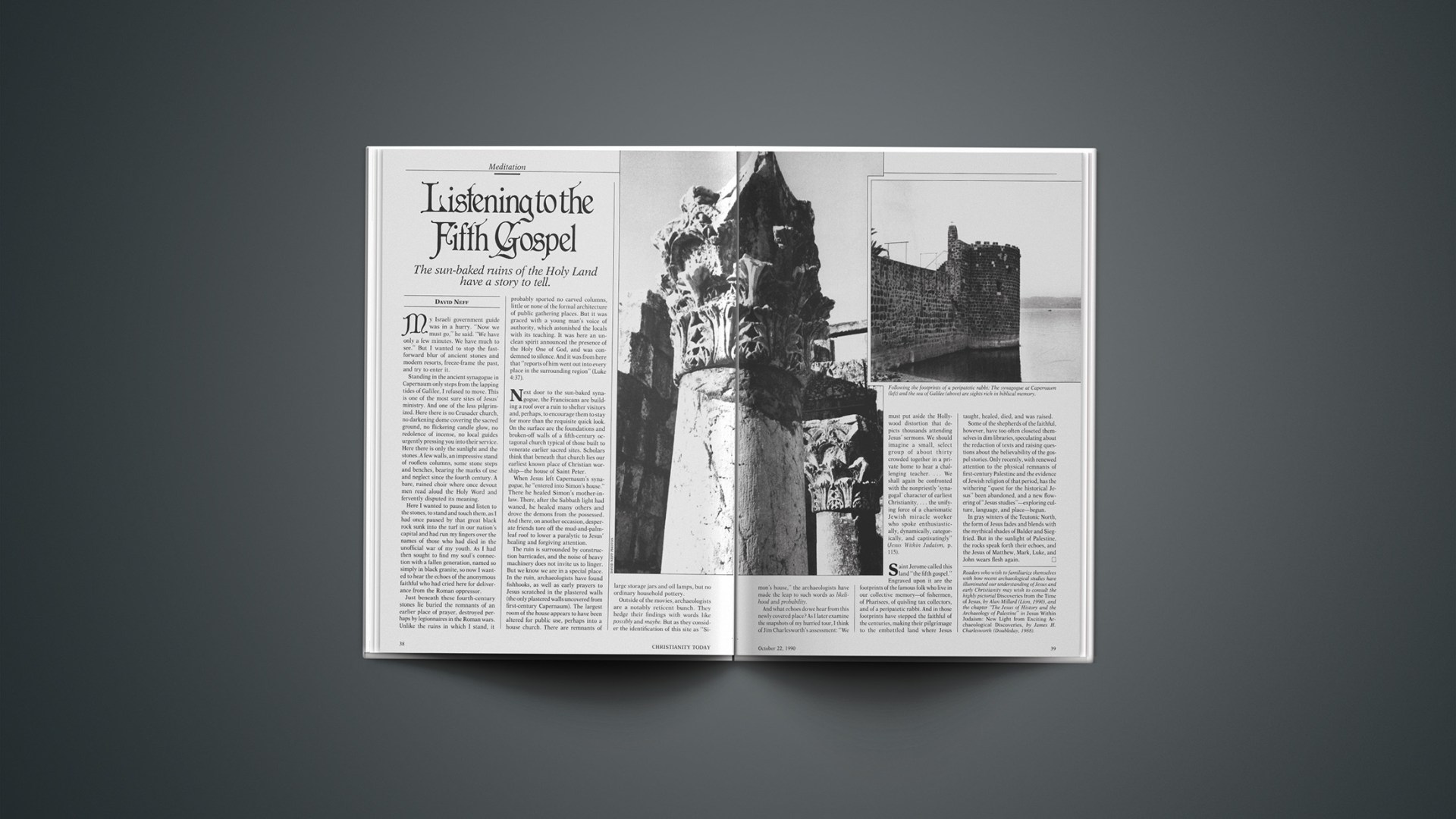The sun-baked ruins of the Holy Land have a story to tell.
My Israeli government guide was in a hurry. “Now we must go,” he said. “We have only a few minutes. We have much to see.” But I wanted to stop the fast-forward blur of ancient stones and modern resorts, freeze-frame the past, and try to enter it.
Standing in the ancient synagogue in Capernaum only steps from the lapping tides of Galilee, I refused to move. This is one of the most sure sites of Jesus’ ministry. And one of the less pilgrimized. Here there is no Crusader church, no darkening dome covering the sacred ground, no flickering candle glow, no redolence of incense, no local guides urgently pressing you into their service. Here there is only the sunlight and the stones. A few walls, an impressive stand of roofless columns, some stone steps and benches, bearing the marks of use and neglect since the fourth century. A bare, ruined choir where once devout men read aloud the Holy Word and fervently disputed its meaning.
Here I wanted to pause and listen to the stones, to stand and touch them, as I had once paused by that great black rock sunk into the turf in our nation’s capital and had run my fingers over the names of those who had died in the unofficial war of my youth. As I had then sought to find my soul’s connection with a fallen generation, named so simply in black granite, so now I wanted to hear the echoes of the anonymous faithful who had cried here for deliverance from the Roman oppressor.
Just beneath these fourth-century stones lie buried the remnants of an earlier place of prayer, destroyed perhaps by legionnaires in the Roman wars. Unlike the ruins in which I stand, it probably sported no carved columns, little or none of the formal architecture of public gathering places. But it was graced with a young man’s voice of authority, which astonished the locals with its teaching. It was here an unclean spirit announced the presence of the Holy One of God, and was condemned to silence. And it was from here that “reports of him went out into every place in the surrounding region” (Luke 4:37).
Next door to the sun-baked synagogue, the Franciscans are building a roof over a ruin to shelter visitors and, perhaps, to encourage them to stay for more than the requisite quick look. On the surface are the foundations and broken-off walls of a fifth-century octagonal church typical of those built to venerate earlier sacred sites. Scholars think that beneath that church lies our earliest known place of Christian worship—the house of Saint Peter.
When Jesus left Capernaum’s synagogue, he “entered into Simon’s house.” There he healed Simon’s mother-in-law. There, after the Sabbath light had waned, he healed many others and drove the demons from the possessed. And there, on another occasion, desperate friends tore off the mud-and-palm-leaf roof to lower a paralytic to Jesus’ healing and forgiving attention.
The ruin is surrounded by construction barricades, and the noise of heavy machinery does not invite us to linger. But we know we are in a special place. In the ruin, archaeologists have found fishhooks, as well as early prayers to Jesus scratched in the plastered walls (the only plastered walls uncovered from first-century Capernaum). The largest room of the house appears to have been altered for public use, perhaps into a house church. There are remnants of large storage jars and oil lamps, but no ordinary household pottery.
Outside of the movies, archaeologists are a notably reticent bunch. They hedge their findings with words like possibly and maybe. But as they consider the identification of this site as “Simon’s house,” the archaeologists have made the leap to such words as likelihood and probability.
And what echoes do we hear from this newly covered place? As I later examine the snapshots of my hurried tour, I think of Jim Charlesworth’s assessment: “We must put aside the Hollywood distortion that depicts thousands attending Jesus’ sermons. We should imagine a small, select group of about thirty crowded together in a private home to hear a challenging teacher.… We shall again be confronted with the nonpriestly ‘synagogal’ character of earliest Christianity, … the unifying force of a charismatic Jewish miracle worker who spoke enthusiastically, dynamically, categorically, and captivatingly” (Jesus Within Judaism, p. 115).
Saint Jerome called this land “the fifth gospel.” Engraved upon it are the footprints of the famous folk who live in our collective memory—of fishermen, of Pharisees, of quisling tax collectors, and of a peripatetic rabbi. And in those footprints have stepped the faithful of the centuries, making their pilgrimage to the embattled land where Jesus taught, healed, died, and was raised.
Some of the shepherds of the faithful, however, have too often closeted themselves in dim libraries, speculating about the redaction of texts and raising questions about the believability of the gospel stories. Only recently, with renewed attention to the physical remnants of first-century Palestine and the evidence of Jewish religion of that period, has the withering “quest for the historical Jesus” been abandoned, and a new flowering of “Jesus studies”—exploring culture, language, and place—begun.
In gray winters of the Teutonic North, the form of Jesus fades and blends with the mythical shades of Balder and Siegfried. But in the sunlight of Palestine, the rocks speak forth their echoes, and the Jesus of Matthew, Mark, Luke, and John wears flesh again.
Readers who wish to familiarize themselves with how recent archaeological studies have illuminated our understanding of Jesus and early Christianity may wish to consult the highly pictorial Discoveries from the Time of Jesus, by Alan Millard (Lion, 1990), and the chapter “The Jesus of History and the Archaeology of Palestine” in Jesus Within Judaism: New Light from Exciting Archaeological Discoveries, by James H. Charlesworth (Doubleday, 1988).










